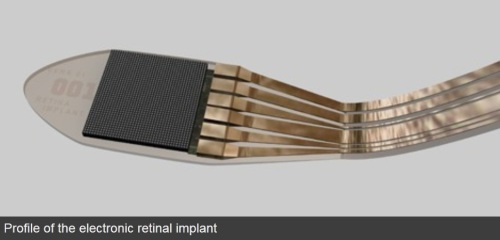Researchers at the Institute for Ophthalmic Research at the University of Tübingen have restored vision in blind patients using tiny retinal implants embedded in the eye.
Nine patients were chosen because they had all suffered hereditary diseases where the retina had degenerated to the point of blindness, but left the remainder of the visual pathway intact. Eight of the nine could still detect some light, although could not locate its source. One was completely blind. Each was implanted with a tiny 3x3mm film square containing 1,500 photodiodes which send out electrical signals when they detect light. The electrical signals are picked up by the nerve cells lying against the retina and passed to the brain. When the retina implant is switched on, the patients perceive a pixellated diamond in the centre of vision, 15 degrees wide.
Light entering the eye is does not contain enough energy to power the electrical pulses from the device, so the retinal implant must rely upon an external power source to amplify the signal. (Previous bionic eye designs used stacks of passive photodiodes and a set of heavy goggles to shine powerful laser stimulators onto the retinal implant.) A foil strip just 17μm thick (six times thinner than printer paper!) exits through the eye and connects to a power cable that travels under the skin to a coil behind the ear. Another coil connected to a power supply attaches magnetically to this point (much like a cochlear implant) and supplies power via transdermic induction - i.e. through the skin. The power supply also has controls which can be used to adjust the contrast and brightness of the retinal signals.
Two thirds of the patients experienced significant improvement in their vision, although a tenth patient was excluded from the trial after the retinal implant accidentally touched against the optic nerve head, seemingly short-circuiting the device (the paper doesn't got into details). Even the patient who enjoyed the most successful implants were given a level of visual ability that most of us would balk at - the refresh rate of the chip is normally just 5Hz (which means it captures a new image every fifth of a second), making high speed motion difficult to detect. Some patients could only operate their implant at one or two frames per second. In addition, the field of view is tiny, and the resolution is poor. Finally, the chip only captures images in black and white. Patients described what they saw as akin to the out-of-focus grey image on old TV set.
However, to the patients themselves, the difference was often dramatic. They reported being able to see people again, objects in a room, food on their plate, colleagues at work and of being able to recognise faces and smiles. Below, one of the patients talks about his experiences with the implant. "For the first time," he says, "I could see everything."
The study is published today in Proceedings of the Royal Society, Artificial Vision with Wirelessly Powered Subretinal Electronic Implant Alpha IMS, Stingl, K. et al.



By having the disease and not being fully blind how does the bionic eye help my visison?
Hi Terkea
Thanks for leaving a comment! First, it's important to note this is an experimental trial - the devices still have not been shown to be safe long term. The gains from the device are, scientifically speaking, 'significant'. This means they were proven to increase the visual acuity of patients by a certain amount. However, all these patients were legally blind in the eye that was treated, so any vision at all would have been an improvement!
How much a retinal implant improves vision depends on how bad vision is to begin with. My guess is that unless you were completely blind, you would not experience much of an 'improvement'. Of course, if the device is proven to be safe, they may become much better in the future and offer partially-sighted people an improvement on their vision.